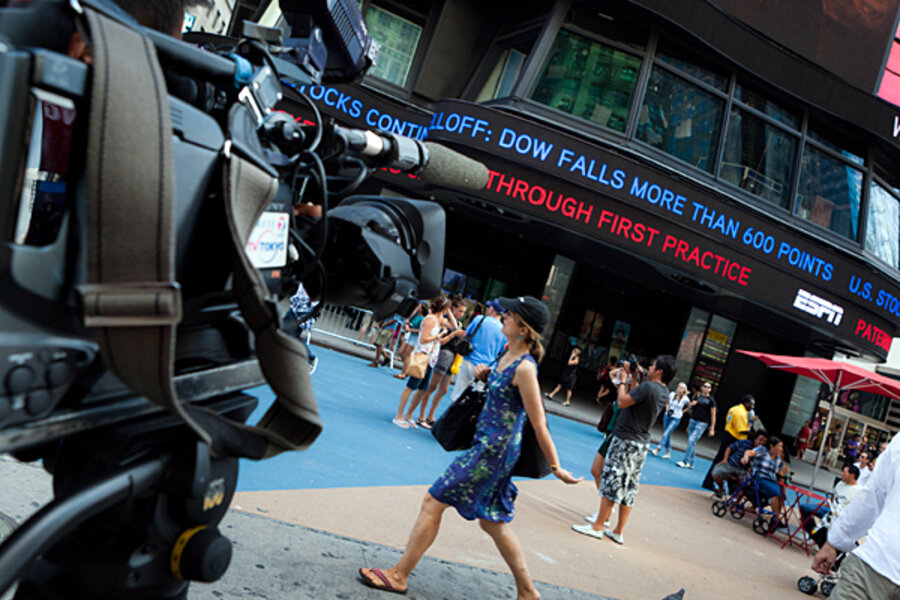Dow drops 1,147 points over three trading days. Is that a 'crash'?
Loading...
| New York
After Black Tuesday, Oct. 29, 1929, Variety declared “Wall Street lays an egg,” to describe a drop of 23 percent in the stock market over two days. In the stock market “crash” of 1987, the Dow Jones Industrial Average lost 22.6 percent of its value in one day. On Monday, the Dow dropped 634.76 points to 10809.85. Does the sharp decline qualify as a “crash?”
To some market observers, the latest decline is merely a “correction,” compared with what happened in 1929 and 1987. Despite the large drop – some 513 points last Thursday, as well – the Dow is down 9.13 percent over three days of trading.
“A stock market crash is in the range of 25 percent or more in one day,” says Fred Dickson, chief investment strategist at D.A. Davidson & Co. in Lake Oswego, Ore. “We’re down about 10 percent in 10 days.”
Here are some of the worst market sell-offs:
Oct. 19, 1987, also called “Black Monday.” Over the weekend before, Iran had fired missiles over the Persian Gulf, causing some nervous moments. But then, an article in The New York Times claimed that the US wanted a lower-valued dollar. This prompted foreign investors to start to dump stocks because they would be worth less money in dollar terms. The markets at the time did not have any circuit-breakers, which now stop trading after about a 10 percent decline in one day.
Instead, the falling markets resulted in yet more selling, which basically snowballed as computer-generated trades kept pressure on the market the entire day. “The only thing that kept the market from melting down even more was the closing bell,” recalls Mr. Dickson.
The next day the Federal Reserve Bank stepped in, reducing interest rates. The stock market reversed itself, moving higher.
Oct. 28 and 29, 1929. On Monday the 28th, the stock market fell 12.82 percent and then dropped another 11.73 percent the next day. The stock market of the 1920 had a lot of “wild West” in it, with little supervision over trading. The public had become enthusiastic buyers of stock, using “margin,” or borrowed money, to finance their purchases. Thus, when the market dropped sharply – in an era when stock prices were not instantaneously known – the public lost most of their savings. This lead to the Great Depression and, eventually, to reforms such as the formation of the Securities and Exchange Commission.
Sept. 17, 2001. After the 9/11 attacks, the markets were closed for three days. When they reopened, investors were unsure of what the attack might mean to consumers. Would they stop buying cars and houses? Would the US economy go into a recession?
The market decline that day of 684 points, or about 7.1 percent, was part of a larger decline of about 20 percent over a month. By March 2002, it had made back all the losses. But then the Enron scandal hit and the so-called “Internet bubble” exploded, resulting in a two-year stock-market decline. The economy slipped into recession.
The financial market debacle of late 2008. The stock market had some bad days as the housing bubble burst and the entire financial system seemed to be on the verge of collapse. On Sept. 29, 2008, the Dow fell 777.68 points, or 6.98 percent. On Oct. 9, it dropped another 678 points, or 7.33 percent. Then, on Dec. 1 it lost another 679.95 points, or 7.7 percent. The economy went into a recession in December 2007, which lasted until June 2009.
The current drop in the market totals 1,147 points between last Thursday and the market close on Monday. What makes this decline unusual, says Dickson, is that it is related to politics, not necessarily economics. For example, on Friday Standard & Poor’s, in lowering the debt rating of the US government from AAA to AA+, cited Washington's dysfunctional and inadequate handling of the debt ceiling extension.
“This time the economy is not in recession, or at least the classic signs of a recession are not there,” he says. “This is one of the first declines due to political problems,” he says, recalling that the last time the stock market had a hiccup due to politics was 1973-74 in the wake of the Watergate scandal.
“That was the last major crisis of confidence due to political problems,” Dickson says.
However, Frank Fantozzi, chief investment strategist at Planned Financial Services in Cleveland, says he would “have no qualms” asserting that the stock market had crashed over the past three trading days. He blames “some unique” events that took place in the short term, causing investors to sell off stocks. For example, there are still concerns over the sovereign debt of some European nations. Because many banks own that debt, concerns have again surfaced about the viability of the banking system. The “debt ceiling debacle” did little to calm investors’ nerves, he adds.
Nonetheless, Mr. Fantozzi sees the market as “close to bottoming out” once investors have a chance to do a deeper analysis. “I think tomorrow will be a big buy-back day,” he says.





